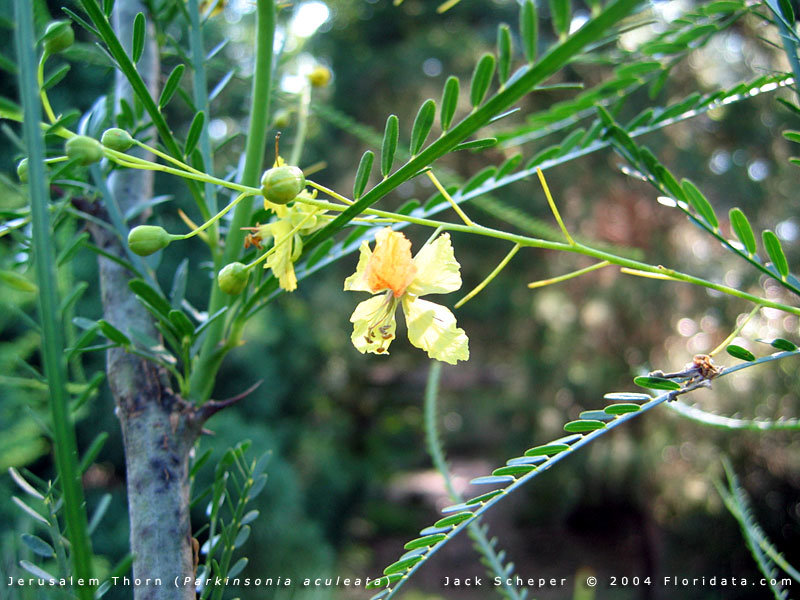Parkinsonia
Flowers and leaves of Parkinsonia aculeata
The Parkinsonien ( Parkinsonia ) are a genus of the subfamily of carob plants ( Caesalpinioideae ) within the legume family ( Fabaceae ). It has a disjoint area: the species are located in semi-arid regions of Africa and America.
- 4.1 Notes and references
Etymology
The genus name honors the English Parkinsonia physician and botanist John Parkinson.
Description
The Parkinsonien are reach large shrubs or small trees, the growth heights of 5-12 meters. You have open, bright, spine reinforced canopy. Its bark is green. In the dry season they throw off their foliage. The change-constant leaves are bipinnate with two to six first-order pinnae and numerous small leaflets. You end up with a spiked tip. They are formed by the rains, but remain mostly consist of only a short time. The majority of the photosynthetic activity is taken over by the green twigs and branches during drought. The stipules are diverse: tiny, scale-like or sometimes transformed into thorns.
The flowers are in axillary, racemose inflorescences with small bracts. The hermaphrodite flowers are (more or less) zygomorph and fünfzählig. The five sepals are slightly uneven and overlap like roof tiles. The five yellow or white petals are slightly unequal. The ten stamens are free. The ovary contains many ovules. The stylus is thin.
Legumes contain several (usually one to ten ) seeds.
Systematics and distribution
Synonyms
Synonyms for Parkinsonia L. are: Cercidiopsis Britton & Rose, Cercidium Tul, Peltophoropsis Chiov, Rhetinophloeum H. Karst ... .
Species
The two to ten (up to 14 ) species can be divided into two groups according to the occurrence in Africa or America:
- Parkinsonia africana. South Africa (Botswana, Namibia, South Africa).
- Parkinsonia anacantha. Kenya.
- Parkinsonia raimondoi. Somalia.
- Parkinsonia scioana. East Africa (Djibouti, Ethiopia, Somalia, Kenya).
- Jerusalem thorn ( Parkinsonia aculeata L., syn: P. spinosa and P. thornberi ). The original home is Texas and Arizona, south to Argentina; Galapagos Islands; but it is wild in many areas of Asia, Africa and Australia.
- Parkinsonia carterae. Western Mexico, southward to Ecuador.
- Parkinsonia florida (syn.: P. torreyana, Cercidium floridum ). Southern California, Arizona, southern Nevada, northwestern Mexico.
- Parkinsonia microphylla ( Syn: Cercidium microphyllum ). Southern California, Arizona, northwestern Mexico.
- Parkinsonia praecox ( Syn: Cercidium praecox ). Mexico, south to Argentina.
- Parkinsonia texana ( Syn: Cercidium texanum ). Texas, northeastern Mexico.
Most American species are known there as " Palo Verde ", Spanish for "green stick" - an allusion to the characteristic green stem, the bark of which takes photosynthetic tasks.
Swell
- SI Ali: Flora of West Pakistan 54: Caesalpiniaceae. Stewart Herbarium, Rawalpindi in 1973, Parkinsonia - Online.
- Entry in the Flora of Zimbabwe.
- Ira Loren Wiggins, Duncan M. Porter, Edward F. Anderson: Flora of the Galápagos Islands, Stanford University Press, Stanford, 1971, p 607 ISBN 0-8047-0732-4, limited preview on Google Book Search




.jpg)





